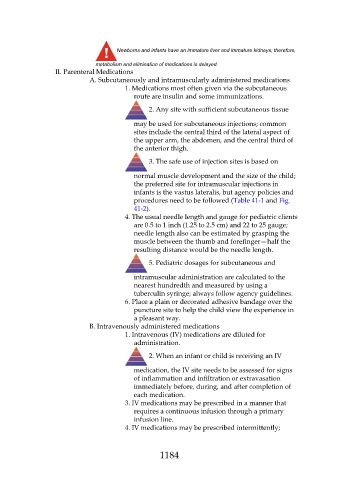Page 1184 - Saunders Comprehensive Review For NCLEX-RN
P. 1184
Newborns and infants have an immature liver and immature kidneys; therefore,
metabolism and elimination of medications is delayed.
II. Parenteral Medications
A. Subcutaneously and intramuscularly administered medications
1. Medications most often given via the subcutaneous
route are insulin and some immunizations.
2. Any site with sufficient subcutaneous tissue
may be used for subcutaneous injections; common
sites include the central third of the lateral aspect of
the upper arm, the abdomen, and the central third of
the anterior thigh.
3. The safe use of injection sites is based on
normal muscle development and the size of the child;
the preferred site for intramuscular injections in
infants is the vastus lateralis, but agency policies and
procedures need to be followed (Table 41-1 and Fig.
41-2).
4. The usual needle length and gauge for pediatric clients
are 0.5 to 1 inch (1.25 to 2.5 cm) and 22 to 25 gauge;
needle length also can be estimated by grasping the
muscle between the thumb and forefinger—half the
resulting distance would be the needle length.
5. Pediatric dosages for subcutaneous and
intramuscular administration are calculated to the
nearest hundredth and measured by using a
tuberculin syringe; always follow agency guidelines.
6. Place a plain or decorated adhesive bandage over the
puncture site to help the child view the experience in
a pleasant way.
B. Intravenously administered medications
1. Intravenous (IV) medications are diluted for
administration.
2. When an infant or child is receiving an IV
medication, the IV site needs to be assessed for signs
of inflammation and infiltration or extravasation
immediately before, during, and after completion of
each medication.
3. IV medications may be prescribed in a manner that
requires a continuous infusion through a primary
infusion line.
4. IV medications may be prescribed intermittently;
1184

